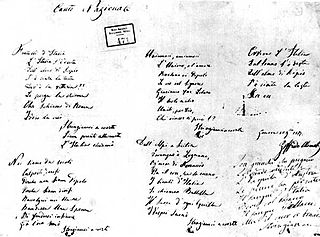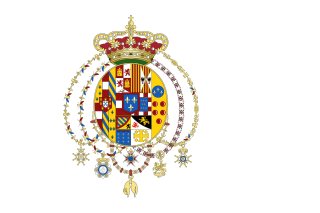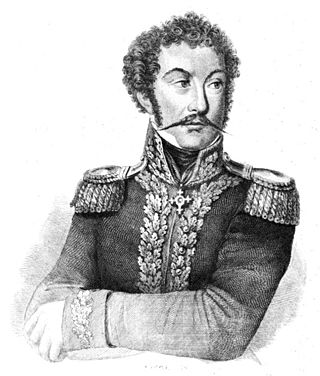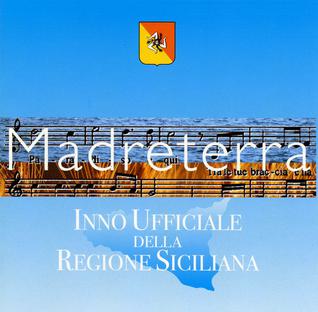Related Research Articles

Goffredo Mameli was an Italian patriot, poet, writer and a notable figure in the Risorgimento. He is also the author of the lyrics of "Il Canto degli Italiani", the national anthem of Italy.

"Il Canto degli Italiani" is a canto written by Goffredo Mameli and set to music by Michele Novaro in 1847, and is the current national anthem of Italy. It is best known among Italians as the "Inno di Mameli", after the author of the lyrics, or "Fratelli d'Italia", from its opening line. The piece, in a time signature of 4/4 and the key of B-flat major, consists of six strophes, and a refrain sung at the end of each strophe. The sixth group of verses, which is almost never performed, recalls the text of the first strophe.

Michele Novaro was an Italian composer.

Southern Italy, also known as Meridione or Mezzogiorno is a macroregion of Italy consisting of its southern regions.

"Suona la tromba" or Inno popolare is a secular hymn composed by Giuseppe Verdi in 1848 to a text by the Italian poet and patriot Goffredo Mameli. The work's title comes from the opening line of Mameli's poem. It has sometimes been referred to as "Grido di guerra".

The Sicilian revolution of independence of 1848 occurred in a year replete with revolutions and popular revolts. It commenced on 12 January 1848, and therefore was the first of the numerous revolutions to occur that year. Three revolutions against Bourbon rule had previously occurred on the island of Sicily starting from 1800: this final one resulted in an independent state surviving for 16 months. The constitution that survived the 16 months was quite advanced for its time in liberal democratic terms, as was the proposal of an unified Italian confederation of states. It was in effect a curtain raiser to the end of the Bourbon kingdom of the Two Sicilies which was started by Giuseppe Garibaldi's Expedition of the Thousand in 1860 and culminated with the siege of Gaeta of 1860–1861 and with the proclamation of the unified Kingdom of Italy.

Vincenzo Cuoco was an Italian writer. He is mainly remembered for his Saggio Storico sulla Rivoluzione Napoletana del 1799. He is considered as one of the precursors of Italian liberalism and the realist school. Cuoco adapted the critique of political rationalism of Edmund Burke and Joseph de Maistre for liberal ends, and has been described as a better historian than either of them. He influenced many subsequent Italian intellectuals, from Ugo Foscolo and Alessandro Manzoni to Bertrando and Silvio Spaventa to Benedetto Croce and Antonio Gramsci.

The Order of Saint George of the Reunion is an order of knighthood of the Kingdom of the Two Sicilies. It was established to replace the Royal Order of the Two-Sicilies.

The Kingdom of the Two Sicilies was a kingdom in Southern Italy from 1816 to 1861 under the control of a cadet branch of the Spanish Bourbons. The kingdom was the largest sovereign state by population and size in Italy before Italian unification, comprising Sicily and most of the area of today's Mezzogiorno in covering all of the Italian Peninsula south of the Papal States.

Giuseppe Maria Rosaroll-Scorza was an Italian essayist and a general in the army of the Kingdom of the Two Sicilies. He was also the father of the Italian patriotic hero Cesare Rosaroll.

Prince Pasquale of Bourbon-Two Sicilies, Count of Bari, full Italian name: Pasquale Baylen Maria del Carmine Giovanni-Battista Vincenzo-Ferreri Michele Arcangel Francesco di Paola Ferdinando Francesco di Assisi Luigi-Re Alfonso Gaetano Giuseppe Pietro Paolo Gennaro Luigi-Gonzaga Giovanni Giuseppe della Croce Gaspare Melchiore Baldassare Alberto Sebastiano Giorgio Venanzio Emanuele Placido Andrea-Avelino Rocco Pacifico Francesco di Geronimo Felice Teziano Ana Filomena Sebazia Lucia Luitgarda Apollina, Principe di Borbone delle Due Sicilie, Conte di Bari was the eleventh child of Ferdinand II of the Two Sicilies and his second wife Maria Theresa of Austria.

The Royal Palace of Portici is a former royal palace in Portici, Southeast of Naples along the coast, in the region of Campania, Italy. Today it is the home of the Orto Botanico di Portici, a botanical garden operated by the University of Naples Federico II. These gardens were once part of the large royal estate that included an English garden, a zoo and formal parterres.
The Inno delle Marche is the official hymn of the Italian region of Marche. Written by the Italian composer Giovanni Allevi, on behalf of regional authorities, it was officially performed for the first time on 1 September 2007 in the town of Loreto. It is one of the few anthems without lyrics.

"Madreterra" [ˌmaːdɾeˈtɛra] is the official anthem of Sicily since 2003. It was the first regional anthem in Italy, and was written by Vincenzo Spampinato, who was chosen after an official competition. However, other songs have been traditionally regarded as national anthems of Sicily. The lyrics are in Italian. Madreterra was performed in public for the first time at the Ancient theatre of Taormina on 14 June 2003 by the Sicilian Symphony Orchestra and the Musa 2000 Choir.

The Royal Navy of the Kingdom of the Two Sicilies was the official term in documents of the era for the naval forces of the Kingdom of the Two Sicilies - it and the Royal Army together formed the Kingdom's armed forces. The modern use of the term Regio for royal was only introduced into the force's title after the annexation of the Kingdom of Sardinia. It was the most important of the pre-unification Italian navies and Cavour made it the model of the new Italian Regia Marina after the annexation of the Two Sicilies.

The Army of the Two Sicilies, also known as the Royal Army of His Majesty the King of the Kingdom of the Two Sicilies, the Bourbon Army or the Neapolitan Army, was the land forces of the Kingdom of the Two Sicilies, whose armed forces also included a navy. It was in existence from 1734 to 1861. It was the land armed force of the new independent state created by the settlement of the Bourbon dynasty in southern Italy following the events of the War of the Polish Succession.

Carlo Troya was a historian and politician who served as Prime Minister of the Two Sicilies from 3 April 1848 until 15 May 1848. Politically, he was a liberal Neo-Guelph who supported Italian unification. His primary historical interest was the study of the Early Middle Ages, to which he made lasting contributions.

The Bourbon Tunnel, Tunnel Borbonico or Bourbon Gallery is an ancient underground passage, constructed for military purposes to connect the Royal Palace to military barracks in Naples, Italy.

Vesuvio was a ship of the line of the Real Marina of the Kingdom of the Two Sicilies, later acquired as a frigate by the Italian Royal Navy. She was initially a French Bucentaure class whose construction began in August 1812, but the works stalled and the ship was transferred to the Kingdom of Naples in 1813.
The Bank of the Tavoliere di Puglia (1835-1845) was a bank located in the city of Foggia, in the Kingdom of the Two Sicilies. Its purpose was to foster the development of the so-called Tavoliere delle Puglie, one of the poorest areas of the Kingdom of the Two Sicilies, but its hidden purpose was probably to defraud Mr. Van-Aken, an investor from Bruxelles who was planning to invest about two million ducats in the Kingdom of the Two Sicilies on behalf of Dutch and Belgian bankers. As stated by Italian economist Luca de Samuele Cagnazzi, the purpose of all the banks in the Kingdom of the Two Sicilies was to commit some kind of bankruptcy fraud, leading to serious harm to the economy of the kingdom, and this was exacerbarted by widespread corruption in the field of justice.
References
- ↑ "Inno borbonico di Paisiello? No, è del barone Pisani" (in Italian).
- ↑ "Inni e Musiche" (in Italian). Monzu Vladi.it. 18 February 2008. Archived from the original on 18 September 2007. Retrieved 5 December 2023.
- ↑ Petronio, Paolo (2017). Gli inni nazionali del mondo (in Italian). p. 90.
- ↑ Nicla Cesaro (10 May 2020). "Sei nuove trascrizioni per l'Inno delle Due Sicilie" (PDF). Rome. Retrieved 4 December 2023.
- ↑ "Petizione: Non toccate l'inno di Paisiello" (in Italian). ANSA. 8 October 2020. Retrieved 4 December 2023.
- ↑ Maiorino, Tarquinio; Marchetti Tricamo, Giuseppe; Giordana, Piero (2001). Fratelli d'Italia: la vera storia dell'inno di Mameli (in Italian). p. 24.
- ↑ "Inno borbonico di Paisiello? No, è del barone Pisani" (in Italian). 3 October 2020.
- ↑ "L'Inno delle Due Sicilie" (in Italian). Elemal.org. 18 February 2008.
- 1 2 "National Anthem by Paisiello". DueSicilies.org. 18 February 2008.